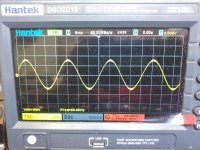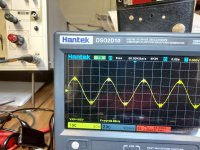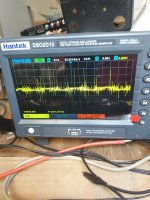Just got this amp in. The owner stated that there was a "little something wrong" with it.
I first made sure that there was no continuity between B+ and GND.
I removed the cover and checked all MOSFETS on diode check and then with the ohms setting and all checked good.
I applied 13.8vdc @ 2A current limit. It maxxed that out, but I was able to see good square waves on the power supply FETS and it was building rail voltage.
I increased the current limit to 4A and it powered up with no problems pulling 2.68A with the remote on and has +/-77.2 vdc rail voltage.
I input a 50Hz sine wave @2vpp and have a good output signal.
I started increasing the gain and as I got to 160vpp, just before clipping, on the outputs I can hear a "buzz" and the peaks of the sine wave get "squiggly".
I do not have a load on the speaker terminals.
I can't pin down exactly where the buzz comes from, but it is in the area of the output filter caps and inductors.
Any clues on where and what to check next?
I first made sure that there was no continuity between B+ and GND.
I removed the cover and checked all MOSFETS on diode check and then with the ohms setting and all checked good.
I applied 13.8vdc @ 2A current limit. It maxxed that out, but I was able to see good square waves on the power supply FETS and it was building rail voltage.
I increased the current limit to 4A and it powered up with no problems pulling 2.68A with the remote on and has +/-77.2 vdc rail voltage.
I input a 50Hz sine wave @2vpp and have a good output signal.
I started increasing the gain and as I got to 160vpp, just before clipping, on the outputs I can hear a "buzz" and the peaks of the sine wave get "squiggly".
I do not have a load on the speaker terminals.
I can't pin down exactly where the buzz comes from, but it is in the area of the output filter caps and inductors.
Any clues on where and what to check next?
Photo of waveform?
Does twisting the inductors make a difference?
Do you see any significant noise on the heatsink at any time?
Does twisting the inductors make a difference?
Do you see any significant noise on the heatsink at any time?
The inductors are solid. Zero movement. No change in output.
The output wave forms were with the scope set to 50v/div, 5mS and a 10x probe.
The "noise" on the heatsink was with the oscope set to 1v/div and 5mS. Scope ground on the speaker negative.
The output wave forms were with the scope set to 50v/div, 5mS and a 10x probe.
The "noise" on the heatsink was with the oscope set to 1v/div and 5mS. Scope ground on the speaker negative.
Attachments
Those aren't ideal but probably nor far from normal.
Do you have enough power supply to run it up to clipping into a load?
Do you have enough power supply to run it up to clipping into a load?
Yes with my other power supply.
I have 2 each 100W 8Ohm non-inductive dummy loads.
Will they work?
If not, my only other option is a large dual 4ohm voice coil sub wired for 2ohms.
I have 2 each 100W 8Ohm non-inductive dummy loads.
Will they work?
If not, my only other option is a large dual 4ohm voice coil sub wired for 2ohms.
The 8 ohm loads in parallel should be a good start. I have used the large cylindrical 100w wirewound resistors for this (with forced air cooling) and they could take this sort of power short term. I don't know if the ones you have can take it.
Just a few seconds with a sine wave should show if there is a serious problem. You could test with music and the resistors should be able to take the power for longer. Testing with the woofer with music would also be good.
Just a few seconds with a sine wave should show if there is a serious problem. You could test with music and the resistors should be able to take the power for longer. Testing with the woofer with music would also be good.
i have this running in my car, (unmolested), if you need readings of anything, i could help, gives me a reason to open it up maybe refresh the thermals.
With the 8 ohm loads in parallel, the amplifier started clipping at ~120vpp.
The "buzz" noise is still present just before clipping.
Couldn't test long. The dummy loads get very hot quickly. They need to be mounted to a heat sink.
Is it possible that a capacitor could make that noise?
I can't really see a bulge on top of one, but it kind of feels as though one is ever so slightly bulged on top.
It's the one on the right in this pic with the black dot.
The "buzz" noise is still present just before clipping.
Couldn't test long. The dummy loads get very hot quickly. They need to be mounted to a heat sink.
Is it possible that a capacitor could make that noise?
I can't really see a bulge on top of one, but it kind of feels as though one is ever so slightly bulged on top.
It's the one on the right in this pic with the black dot.
Attachments
If you're still getting the noise at the top/bottom of the waveform that may be enough to induce noise in the filter components.
If the capacitors were bad, I'd expect to see a lot more noise on the entire waveform.
Can you get a better description of the problem from the owner?
If the capacitors were bad, I'd expect to see a lot more noise on the entire waveform.
Can you get a better description of the problem from the owner?
The owner got back with me today.
He said that it would power up and then shut off. I haven't had that problem.
I am going to connect the sub I have and play some music through it.
He said that it would power up and then shut off. I haven't had that problem.
I am going to connect the sub I have and play some music through it.
- Home
- General Interest
- Car Audio
- SoundStream TA1.3000D



